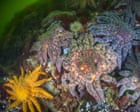
Human innovation is continuously paving the way for a brighter future, as illustrated by recent discoveries in both the natural world and the realm of artificial intelligence. In the peaceful confluence of nature and technology, two significant advancements have emerged, promising a positive impact on our world.
In the serene underwater landscapes of the western coast of North America, a notable breakthrough in marine biology has brought renewed hope to conservationists worldwide. Scientists have identified a particular strain of bacterium, Vibrio pectenicida, as the prime factor behind the sea star wasting disease (SSWD), which has had devastating effects on sunflower sea stars (Pycnopodia helianthoides). Over the last decade, these starfish have faced a precipitous decline, with a staggering 90% loss in population—approximately 5.8 billion since 2013. Once vibrant inhabitants of the ocean floor, many of these sea stars are now listed as critically endangered by the International Union for Conservation of Nature (IUCN). Uncovering the microbial culprit of this widespread disease is an essential first step toward mitigating its impacts and restoring balance to marine ecosystems.
In a realm far removed from the quiet depths of the sea, the journey towards artificial general intelligence (AGI) is making remarkable progress with Google’s latest technological leap. The creation of “Genie 3,” a sophisticated world model, stands at the forefront of this endeavor, allowing artificial intelligence systems to simulate and interact within lifelike environments. The advanced capabilities of Genie 3 hold significant promise for training robots and autonomous vehicles, providing a realistic platform to hone their skills and efficiency. By imitating environments like warehouses, AGI can further refine the operations of these intelligent machines, making them more adept at navigating complex tasks.
This harmony of scientific discovery in marine biology and artificial intelligence reflects humanity’s enduring quest for understanding and innovation. As scientists and researchers continue to explore the mysteries of the ocean and the capabilities of AI, each step forward brings with it the potential to address pressing global challenges and enrich our lives.
With the newfound knowledge of the bacterium causing the sea star wasting disease, researchers and conservationists are now better equipped to tackle this ecological crisis. Potential interventions and restorative strategies can be developed with precision, aiming to curb the progression of the disease and support the resurgence of the sunflower sea star population, ensuring that these vital players in marine ecosystems can thrive once more.
Simultaneously, the progress made in AI serves as a testament to the power of human ingenuity. As researchers at Google continue to refine the Genie 3 world model, the possibilities for its application are boundless. Whether it’s improving the efficiency of industrial operations, enhancing the safety of autonomous vehicles, or even exploring new frontiers in robotics, this advancement marks a significant milestone in the pursuit of machines that can learn and adapt with human-like precision.
These stories of scientific and technological achievement resonate with a profound message of hope and possibility. They remind us of the interconnectedness of all things and the power of knowledge to transform our understanding of the world. As we look to the future, the collaboration between the realms of nature and technology offers an exciting promise of progress—one that is grounded in respect for our planet and fueled by the spirit of innovation.
Source: {link}
